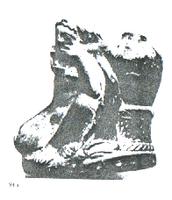
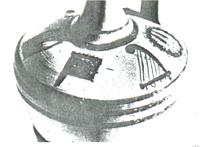
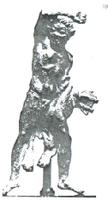
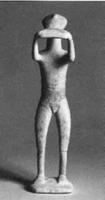 Syrinx (Panflöte)
Syrinx (Panflöte)Desweiteren sind uns drei kykladische Marmorstatuetten von Syrinxspielern überliefert. Die Syrinx hatte als ein einfach herzustellendes Instrument immer seinen Platz bei den einfachen Leuten und besonders bei den Hirten, die sich damit ihre Zeit vertrieben. Als Material kommt Schilf, Ton oder auch Stein in Betracht. Da die Instrumente alle eine rechteckige Form aufweisen, wurde die unterschiedlichen Tonhöhen durch Auffüllen mit Wachs erreicht. Interessanterweise wird die Syrinx nach der Zeit der Kykladenkultur bis gegen 600 v. Chr. nicht mehr dargestellt, die früheste literarische Erwähnung findet sich bei Homer, Ilias X 13 und XVIII 526. Später wird sie das Instrument des Hirtengottes Pan, von dem das Instrument seinen Namen hat.
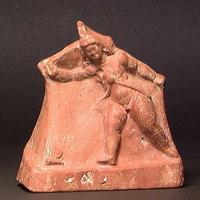
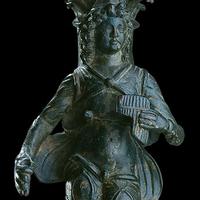 Attis, Statuette Salonique Grθce bronze (Musιe du Louvre)
Attis, Statuette Salonique Grθce bronze (Musιe du Louvre)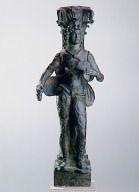



 The sacred tree of Attis (Henderson & Oakes).
The sacred tree of Attis (Henderson & Oakes)."Two different accounts death of the death of Attis were current. According to the one he was killed by a boar, like Adonis. According to the other he unmanned himself under a pine - tree, and bled to death on the spot. The legend of which the story forms a part is stamped with a character of rudeness and savagery that speaks strongly for its antiquity. In like manner the worshippers of Adonis abstained from pork, because a boar had killed their god.' After his death Attis is said to have been changed into a pine-tree."
www.dhushara.com/ book/eve/eve.htm
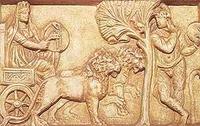
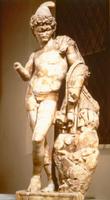 www.comune.sarsina.fo.it/ museoarch/museo.htm
www.comune.sarsina.fo.it/ museoarch/museo.htm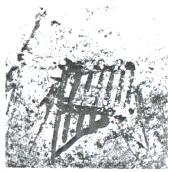
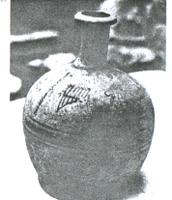
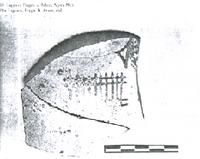

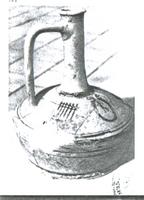
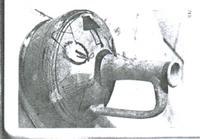
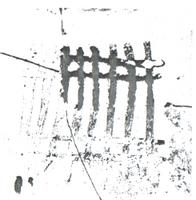
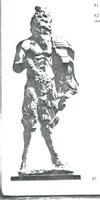
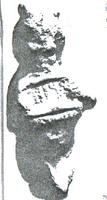
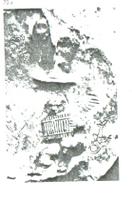

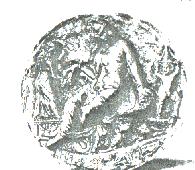
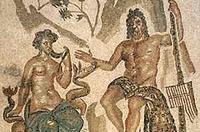 La flûte de Pan, dont l'origine remonte à la plus haute antiquité, tire son nom d'une légende grecque.
La flûte de Pan, dont l'origine remonte à la plus haute antiquité, tire son nom d'une légende grecque.Le dieu Pan, pâtre étrange à l'aspect effrayant par ses cornes, sa barbe et ses sabots de bouc, aperçoit un jour dans la forêt une nymphe d'une rare beauté nommée Syrinx. Il en tombe éperdument amoureux et veut lui déclarer son amour.
Epouvantée, la jeune fille s'enfuit et se jette dans les bras de son père, le fleuve Ladon. Elle se trouve transformée en un roseau que Pan, dans sa colère, casse en plusieurs morceaux de longueurs inégales .
Regrettant immédiatement son geste, le dieu dépose un baiser sur chacun des bouts asssemblés et... miraculeusement, de chacun sort un son différent. Alors rassemblés, les tubes se mettent à chanter la douleur de son amour perdu.
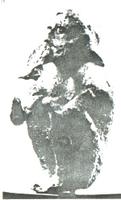
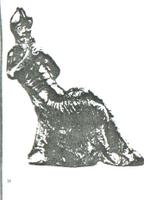
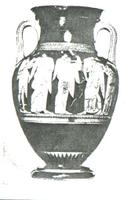
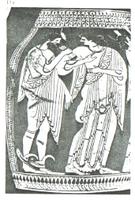
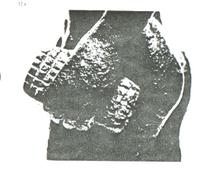


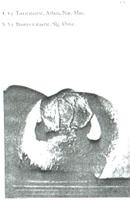
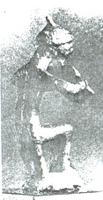
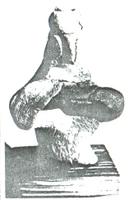

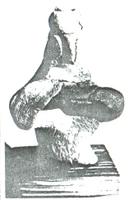

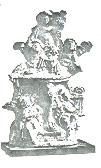
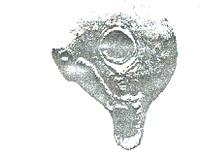
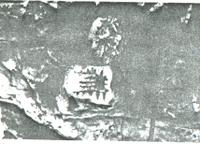

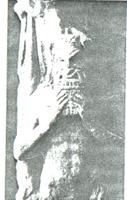
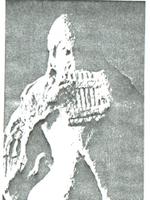
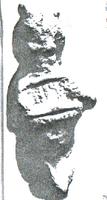
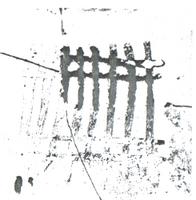
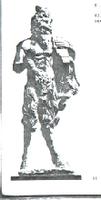

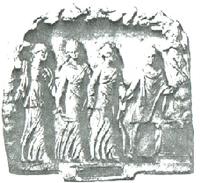

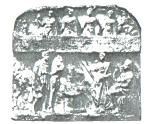
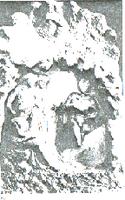
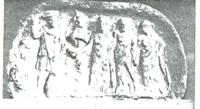
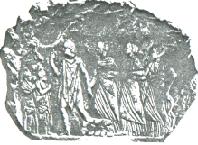
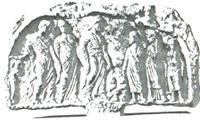

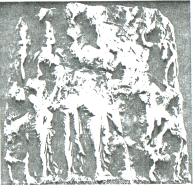
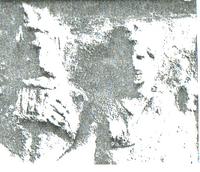

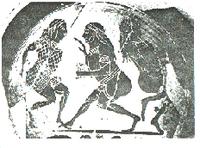
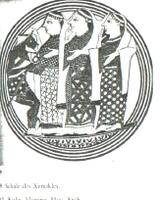
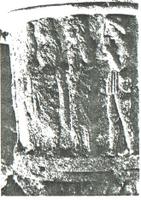
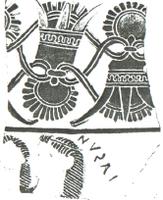
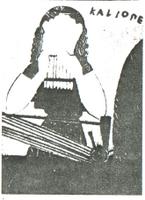

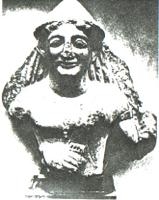
 :)
:)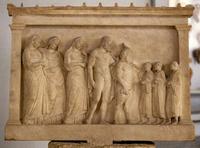 Λατρευτές πλησιάζουν τον Πάνα, τον Ερμή και τις Νύμφες, -4ος αι., Αθήνα
Λατρευτές πλησιάζουν τον Πάνα, τον Ερμή και τις Νύμφες, -4ος αι., Αθήνα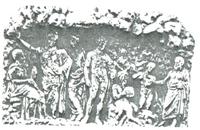
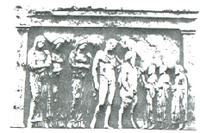
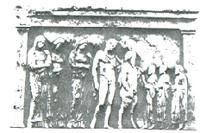


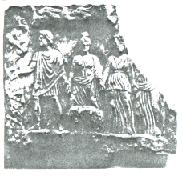
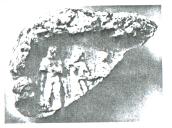

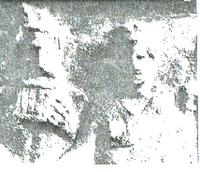



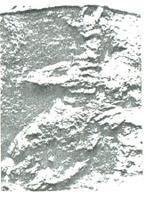
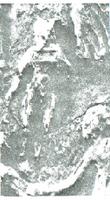
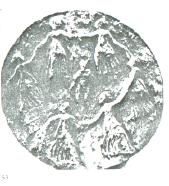
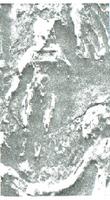
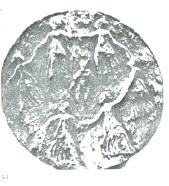
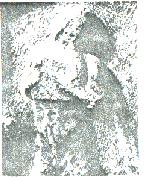
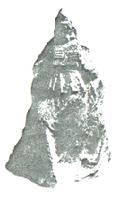
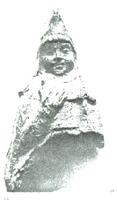
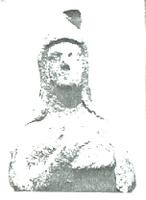
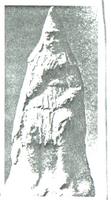

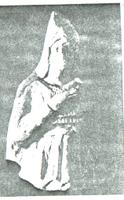
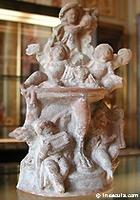 Groupe de cinq Erotes
Groupe de cinq ErotesItem 166 on 211
Greek Antiquities
Sculpture (Groupe)
Material : Terracotta
Date : Ist century B.C.
Artist : Anonyme
Place : Louvre Museum
Figurines en terre cuite grecques
Sully Wing - First floor - Section 38
Area related : Myrina (Turkey)
Acquisition : Fouilles de l'Ecole française d'Athènes (1883)
Description
Les deux Erotes assis sous la table jouent de la syrinx et de la lyre. La syrinx (flûte de Pan), constituée de l'assemblage de plusieurs tubes en roseau et même longueur, est associée à la vie pastorale et à la poésie bucolique.
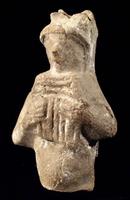 TERRACOTTA FRAGMENT
TERRACOTTA FRAGMENTI - II centuries A.D.
Front molded. Standing figure, wearing hat with two horns, facial features shown schematically. Clutching syrinx to his chest with both hands. Distended abdomen. Perforation at top of head, suggesting a marionette type. Part below abdomen is missing, remainder is intact. H. 3.9" (9.9 cm).
Perhaps a figure of an actor playing Pan from Satyr-Play or other farce related to Dionysos.
For similar see: Ribakov B.A. Archaeology of USSR. Summery of archaeological sources. Terracotta Figures. Part III. Moscow, 1974, table 54.
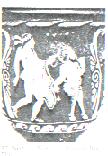
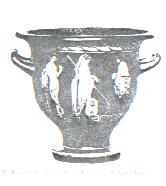
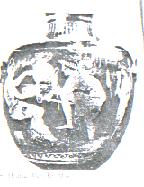
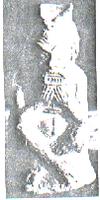



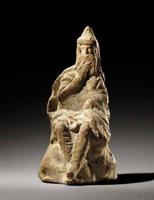
A HELLENISTIC TERRACOTTA FIGURE OF ATTIS, AMPHIPOLIS, 2ND/1ST CENTURY B.C.
LOCATION ESTIMATE AUCTION DATE
London, New Bond Street 2,000—3,000 GBP Session 1
31 Oct 03 11:00 AM
Lot Sold. Hammer Price with Buyer's Premium: 3,000 GBP
19.5cm. high; 7 3/4 in.
DETAILED DESCRIPTION
seated on a rocky outcrop and holding the syrinx flute to his mouth with his right hand, and wearing trousers, tunic with long sleeves, cloak, and Phrygian cap; traces of white slip
PROVENANCE
John Hewett, London
EXHIBITED
Birmingham Museum & Art Gallery, Ancient Life in Miniature. An Exhibition of Classical Terracottas from Private Collections in England, 12th October to 30th November 1968, p. 35, no. 139, pl. 27 (reversed)
CATALOGUE NOTE
For similar examples Cf. F. Winter, Die antiken Terrakotten, III: Die Typen der figόrlichen Terrakotten, part II, Berlin and Stuttgart, 1903, pl. 371, nos. 7 and 8, and M. Velickovic, Catalogue des terres cuites grecques et romaines, Musιe National, Beograd, Belgrade, 1957, pl. XVI, fig. 33. See also R.A. Higgins, Greek Terracottas, London, 1967, p. 105, pl. 48F
 η κεφαλή της Καρυάτιδος από το Ιερό του Απόλλωνα στους Δελφούς, λαμπρό έργο της αρχαϊκής γλυπτικής του 6ου αι. π.Χ.
η κεφαλή της Καρυάτιδος από το Ιερό του Απόλλωνα στους Δελφούς, λαμπρό έργο της αρχαϊκής γλυπτικής του 6ου αι. π.Χ.http://www.cultureguide.gr/events/details_gr.jsp?Event_id=50495&catA=9
 Abb. 4: Terrakotta; ptolemäisch; Sammlung Berlin Nr. 8798; Hickmann (1961:95, Abb. 58).
Abb. 4: Terrakotta; ptolemäisch; Sammlung Berlin Nr. 8798; Hickmann (1961:95, Abb. 58).
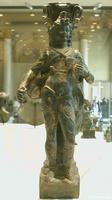
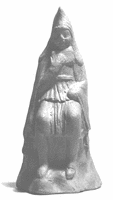
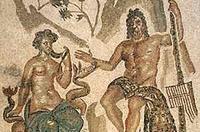 La légende la nymphe Syrinx
La légende la nymphe SyrinxLa flûte de Pan, dont l'origine remonte à la plus haute antiquité, tire son nom d'une légende grecque.
Le dieu Pan, pâtre étrange à l'aspect effrayant par ses cornes, sa barbe et ses sabots de bouc, aperçoit un jour dans la forêt une nymphe d'une rare beauté nommée Syrinx. Il en tombe éperdument amoureux et veut lui déclarer son amour.
Epouvantée, la jeune fille s'enfuit et se jette dans les bras de son père, le fleuve Ladon. Elle se trouve transformée en un roseau que Pan, dans sa colère, casse en plusieurs morceaux de longueurs inégales .
Regrettant immédiatement son geste, le dieu dépose un baiser sur chacun des bouts asssemblés et... miraculeusement, de chacun sort un son différent. Alors rassemblés, les tubes se mettent à chanter la douleur de son amour perdu.
 Marble statue of goat-footed Pan. He is wearing an ox-skin. In his left hand he is holding a syrinx (Pan-pipe).
Marble statue of goat-footed Pan. He is wearing an ox-skin. In his left hand he is holding a syrinx (Pan-pipe).http://www.grisel.net/athens_museum.htm

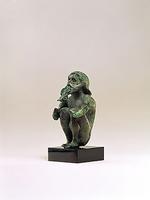 Bronze
BronzeH: 4.4 cm
Allegedly from Syracuse
West Greek
First quarter of the 5th century B.C.
http://www.georgeortiz.com/ortiz_test/indexv.asp?itemid=v135
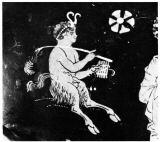 Vase Number 1003948
Vase Number 1003948Fabric SOUTH ITALIAN, APULIAN
Technique RED-FIGURE
Shape Record KRATER, BELL
Current Collection Goteborg, Rohsska Mus: 13.71
Publication Record Corpus Vasorum Antiquorum: GOTEBORG, PUBLIC COLLECTIONS, 81, 82, FIG.246, PL.(102) 37.1-5
View Whole CVA Plates
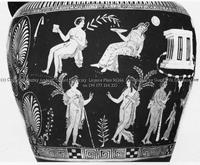
 http://www.beazley.ox.ac.uk/XDB/ASP/browse.asp?tableName=qryData&newwindow=&BrowseSession=1&companyPage=Contacts
http://www.beazley.ox.ac.uk/XDB/ASP/browse.asp?tableName=qryData&newwindow=&BrowseSession=1&companyPage=Contacts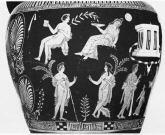 Vase Number 9008620
Vase Number 9008620Fabric SOUTH ITALIAN, APULIAN
Technique RED-FIGURE
Shape Record MUG
Decoration A: RETURN OF ALKESTIS (?) - ABOVE: PAN AND SYRINX, SEATED WOMAN WITH PHIALE, ALTAR ENCIRCLED BY INFULA WITH BUKRANION, SEATED WOMAN WITH CROSS-BAR TORCH (PERSEPHONE?), YOUTH AND SATYR; BELOW: APOLLO AND ADMETOS, HERAKLES, ALKESTIS BETWEEN TWO SMALL CHILDREN, PAIDAGOGOS AND SEATED WOMAN WITH PHIALE
Current Collection 1: Fiesole, A. Costantini
Publication Record Corpus Vasorum Antiquorum: FIESOLE, COLLEZIONE COSTANTINI 2, 18-19, PLS.(2578,2579,2580) 18.1-3, 19.1-2, 20.1
View Whole CVA Plates
Publication Record Trendall, A.D. and Cambitoglou, A., The Red-Figured Vases of Apulia (Oxford, 1978): 427.68
Pair of Tibiae and Syrinx. [Image] (17.46)
Beazley Archive
- Jena, Friedrich-Schiller-Universitat, 423: CHOUS; ETHIOP PAINTER; DIONYSOS, WITH SYRINX, LEANING ON THYRSOS, SATYR PLAYING PIPES [Beazley Archive Vase] (7.57)
- Rome, Mus. Naz. Etrusco di Villa Giulia: CUP; EUERGIDES PAINTER; ATHLETE, DISKOBOLOS, KOMOS (?), YOUTHS WITH APE HEADS (MASKS ?), ON SEESAW, SATYR SEATED ON ROCK WITH SYRINX, GOATS [Beazley Archive Vase] (6.23)
- Munich, Antikensammlungen, J405: AMPHORA A; NIKOXENOS PAINTER; (continued) IRIS WITH OINOCHOE AND PHIALE, ATHENA, POSEIDON SEATED WITH DOLPHIN, HERMES, HERMES WITH SYRINX, APOLLO WITH KITHARA, DIONYSOS, WOMEN, ONE WITH KROTALA, OLYMPOS, ZEUS WITH SCEPTRE SURMOUNTED BY EAGLE SEATED, ON CHAIR SPHINXES AND WRESTLING YOUTHS [Beazley Archive Vase] (5.89)
- Boston (MA), Museum of Fine Arts, 98.887: PYXIS; HESIOD PAINTER; MUSES, ONE PLAYING LYRE, SOME WITH KITHARAI, ONE PLAYING PIPES, ONE WITH PHIALE AND SYRINX, ONE WITH FILLET, SOME SEATED ON STOOLS, DRAPED MAN OR YOUTH LEANING ON STAFF, (HESIOD OR ARCHILOCHOC ?) BULL, TREE, PLANTS [Beazley Archive Vase] (5.27)
 http://blog.arlt.co.uk/blog/Chedworth/_archives/2004/6/26/95080.html
http://blog.arlt.co.uk/blog/Chedworth/_archives/2004/6/26/95080.html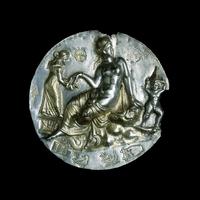 Silver medallion with Aphrodite seated on a rock
Silver medallion with Aphrodite seated on a rockMade and found at Taranto, southern Italy
About 300-200 BC
Waiting on Aphrodite
This silver medallion may have originally ornamented a bowl. It shows the goddess Aphrodite taking something offered to her by a girl attendant. The girl is standing on a pedestal and seems to have either leaves or a piece of cloth in her hands. Aphrodite, goddess of beauty, sits languidly, half-draped, on a rock decorated with flowers, and turns to look at Eros, usually shown as her attendant, but here playfully putting an upturned basket on his head.
The figures are hammered up from the back of the disc by the repoussé technique. The ornaments in the background and below are incised into the metal, with details picked out by gilding. On the left is a long-handled, heart-shaped fan, and in the background a flower and a butterfly with half-folded wings. Below are musical instruments, a set of pipes on the left and a lyre to the right, with a bird and grass-hopper (cicada) between, each with a star or flower.
Diameter: 9.3 cm
GR 1853.3-14.1 (Silver 71)
Room 73, The Greeks in Southern Italy, case 75
D.E. Strong, Greek and Roman gold and silver plate (London, Methuen, 1966)
A. Oliver, Silver for the gods: 800 years of Greek and Roman silver (Toledo Museum of Art, 1977)
http://www.thebritishmuseum.ac.uk/compass/ixbin/hixclient.exe?_IXDB_=compass&_IXSR_=qc6&_IXSS_=_IXFPFX_%3d%252e%252e%252fcompass%252fgraphical%252ffull%252f%26_IXNOMATCHES_%3d%252e%252e%252fcompass%252fgraphical%252fno_matches%252ehtml%26%2524%2b%2528with%2bv2_searchable_index%2529%2bsort%3d%252e%26_IXDB_%3dcompass%26%257bUPPER%257d%253av2_free_text_tindex%3dinstruments%26_IXsearchterm%3dinstruments&_IXFIRST_=22&_IXMAXHITS_=1&_IXSPFX_=graphical/full/&_IXsearchterm=instruments&submit-button=summary
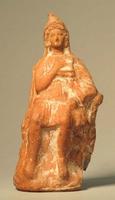 http://www2.szepmuveszeti.hu/hyperion/targy.php?id=463
http://www2.szepmuveszeti.hu/hyperion/targy.php?id=463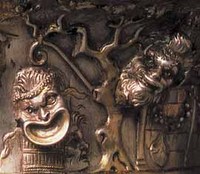 Grotesque theater masks on a silver cup.
Grotesque theater masks on a silver cup.Hildesheim treasure, late 1st century B.C.
http://masca.museum.upenn.edu/roman_wineii/bacchic/bacchus_2.html
 Λίγο πιο κάτω, αμέσως δεξιά της Βασιλέως Κωνσταντίνου και δίπλα στο σημείο όπου σήμερα βρίσκεται το εκκλησάκι της Αγίας Φωτεινής, υπήρχε μια σπηλιά που, σύμφωνα με τους αρχαιολόγους, κατά την Πελασγική εποχή θα πρέπει να είχε χρησιμοποιηθεί ως κατοικία. Η σπηλιά αυτή ονομαζόταν (και ονομάζεται) "σπήλαιο του Πανός" επειδή στη δεξιά κάθετη πλευρά της υπήρχε σκαλισμένη η μορφή του Πάνα.
Λίγο πιο κάτω, αμέσως δεξιά της Βασιλέως Κωνσταντίνου και δίπλα στο σημείο όπου σήμερα βρίσκεται το εκκλησάκι της Αγίας Φωτεινής, υπήρχε μια σπηλιά που, σύμφωνα με τους αρχαιολόγους, κατά την Πελασγική εποχή θα πρέπει να είχε χρησιμοποιηθεί ως κατοικία. Η σπηλιά αυτή ονομαζόταν (και ονομάζεται) "σπήλαιο του Πανός" επειδή στη δεξιά κάθετη πλευρά της υπήρχε σκαλισμένη η μορφή του Πάνα.www.iranon.gr/ATHINA/ATHINA14bTEXT.htm
Pan pipes
One of the famous legends of Pan involves the origin of his trademark pan pipes.
Syrinx was a beautiful nymph beloved by the satyrs and other wood dwellers. She scorned them all.
As she was returning from the hunt one day, Pan met her. She ran away and didn't stop to hear his compliments, and he pursued until she came to the bank of a river where he overtook her.
She had only time to call on the water nymphs for help. Just as Pan laid hands on her, she was turned into the river reeds.
When the air blew through the reeds, it produced a plaintive melody.
The god took some of the reeds to make an instrument which he called a syrinx, in honor of the nymph.
Greek god Pan with pan pipe. 0-200 AD.
Syrinx was a beautiful nymph beloved by the satyrs and other wood dwellers. She scorned them all.
As she was returning from the hunt one day, Pan met her. She ran away and didn't stop to hear his compliments, and he pursued until she came to the bank of a river where he overtook her.
She had only time to call on the water nymphs for help. Just as Pan laid hands on her, she was turned into the river reeds.
When the air blew through the reeds, it produced a plaintive melody.
The god took some of the reeds to make an instrument which he called a syrinx, in honor of the nymph.
Greek god Pan with pan pipe. 0-200 AD.

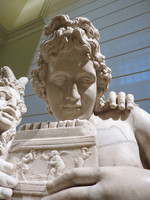
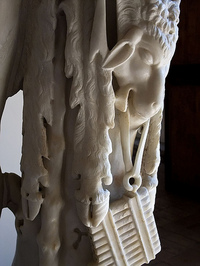
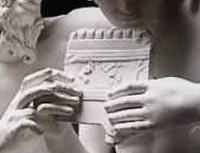
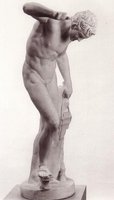
http://www.skulpturhalle.ch/sammlung/highlights/2009/03/aufforderung.html
http://www.icobase.com/?m=200909
Panpipes: BM 1888,0512.742
Sep 22
2009 Comments Off
BM 1888,0512.742
Location: British Museum
Medium: Moulded baked clay
Period: 200 BC to 200 AD, Hellenistic?
Description: A young naked pan-pipe player. Note that the smaller sized pipes on the instrument are to the left of the musician as is typical of Greece. This indicates that the musical system might have been descending. It is difficult to say if the musician is winged as the right ‘wing’ is missing.
BM 1888,0512.742

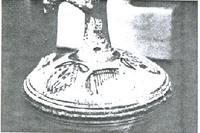
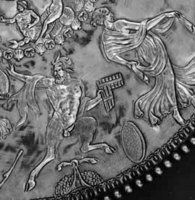
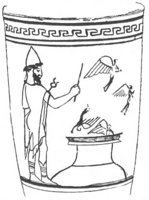

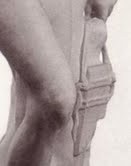
Δεν υπάρχουν σχόλια:
Δημοσίευση σχολίου